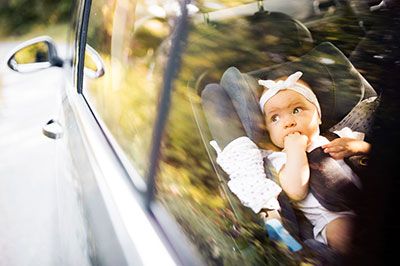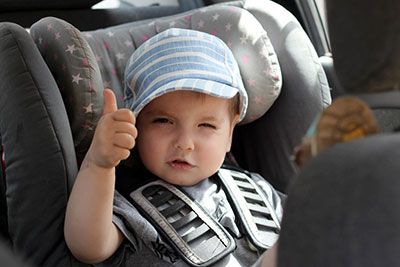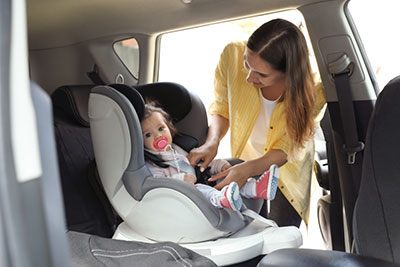It is no secret that babies tend to overheat in their car seats, especially in the summer months. This can be a severe problem - too much heat and your baby could become dangerously overheated.
So how do you know when it's too hot for your little one? And how to keep a baby cool in the car seat? This blog post will explore the best ways to monitor and avoid excessive heat while keeping your precious bundle of joy safe and comfortable while they are tucked away in their car seats.
Read on as we highlight why understanding the basics of temperature control is essential for parents, along with some expert-recommended tips & tricks for ensuring your baby stays at a safe and comfortable temperature during each ride.
More...
Take Away Key Points:
Why is overheating in the car seat dangerous?
Overheating in the car seat can be dangerous for a few reasons. First, infants and young children are more vulnerable to heat exhaustion and heatstroke than adults because they have less efficient sweat glands, making it harder to regulate their body temperature. When a baby's body temperature rises too high, it can lead to dehydration, lethargy, confusion, seizures, or even death.
In addition, car seats and other infant carriers can trap heat and restrict airflow around your baby's body, making overheating more likely in hot weather conditions. That's why it's crucial to take steps to keep your baby cool and comfortable while they're in the car seat.
It's important to note that leaving a child unattended in a parked car is never safe, even for a few minutes. In just a short period, temperatures inside a vehicle can rise rapidly and become life-threatening for anyone inside. So always ensure that you're monitoring your child's temperature closely and taking appropriate measures to keep them cool when traveling by car during hot weather conditions.

Effective ways to keep the baby cool in the hot car seat
1. Use a sunshade
Using a sunshade can help keep the baby cool in the rear-facing car seat by blocking the sun's rays and reducing the amount of heat entering the car. When sunlight shines through the windows of a vehicle, it can quickly heat the interior, making it uncomfortable for anyone inside, including your baby.
A sunshade is designed to reflect sunlight away from the car's reflective surface and the front windshield and prevent it from penetrating through the windows. This can help keep your baby's car seat and surrounding area cooler and more comfortable and block UV radiation. Window shades come in different types, including those that attach directly to the window or those that attach to the child's car seat itself.
Using window shades creates a barrier between your baby and direct sunlight, which can help reduce their risk of overheating.
It's important to note that while a sunshade can effectively keep the baby cool, it should not be used as a substitute for other cooling methods, such as dressing your baby in lightweight clothing or using a portable fan. It can also prevent overheating of the child and be used in combination with the front vents.
However, be careful of the fans, spray bottles, and similar! Although they can help keep the cool temperature, they can also be a projectile risk and a choking hazard! Also, make sure to avoid the shades that block the driver's view! These can often be the shades that stick on the back window!
2. Using a window tint can keep the baby cool
Tinted windows can help keep the baby cool in the convertible car seat by reducing the heat that enters the car through the windows. Window tint is a thin, transparent film applied to car windows' interiors. It's designed to block out a certain percentage of visible light and ultraviolet (UV) rays from the sun.
When sunlight shines through untinted windows, it can create a greenhouse effect inside the car, trapping heat and making it uncomfortable for anyone inside. Applying window tint reduces the amount of sunlight that enters through the windows, which can help keep your baby's car seat and surrounding area cooler.
Window tint comes in different levels of shading or darkness, with varying degrees of UV blocking capabilities. The higher the UV-blocking ability the window tint has, the more effective it will be at keeping out heat and protecting your baby from harmful UV rays.
It's important to note that regulations on window tinting vary by state or country. Therefore, checking local laws before having your car windows tinted is vital to ensure you're within legal limits.
However, using roller shades on the side windows is not recommended! Many parents consider this a cheaper alternative, but the metal buckles on the shades and the loose installation can quickly become projective and harm the baby.
3. Dress the baby in lightweight clothing

Dressing the baby in lightweight and dry clothing can help keep them cool in the car seat by allowing air to circulate around their body, which helps to evaporate sweat and regulate their body temperature. When it's hot outside, heavy or tight-fitting clothing can trap heat against the skin, making your baby feel uncomfortable and potentially leading to overheating.
Lightweight clothing from breathable fabrics like cotton or linen is ideal for keeping babies cool. These materials allow air to flow through them, which allows heat to escape from the body. Loose-fitting clothing is also recommended as it doesn't restrict movement or airflow.
It's essential to dress your baby appropriately for the weather conditions when you know you'll be traveling with them in a car seat. This will help ensure that they remain comfortable and safe throughout the journey.
4. Use a cooling towel or a blanket
Using a cooling towel or blanket can help keep the baby cool in the car seat by providing a source of evaporative cooling. These towels or blankets are typically made from materials that retain water and can be soaked in cold water before use. Once wet, they can be draped over the baby to provide an excellent and refreshing sensation.
The process of evaporative cooling occurs as water molecules absorb heat from the skin and then evaporate into the air. This helps to lower the body temperature and reduce discomfort caused by overheating. Cooling towels or blankets can also be used with other methods, such as window tinting or dressing the baby in lightweight clothing for optimal cooling effect.
It's important to note that while using a cooling towel or blanket can help keep your baby comfortable during hot weather conditions, it's essential not to let them become too cold. Overexposure to cold temperatures can lead to hypothermia, a dangerous condition requiring immediate medical attention. Therefore, it's recommended that you monitor your baby's temperature regularly and remove any cooling items if they begin to show signs of being too cold.
If you want to keep the car seat cool when it's not in use, use a car seat cover.
5. Be careful with the car seat color choice
Using light-colored car seats can help keep the baby cool by reflecting sunlight and reducing heat absorption. However, dark-colored materials absorb more heat than lighter-colored materials, making the hot car seat uncomfortable for the baby.
When exposed to direct sunlight, dark colors such as black or navy blue can reach temperatures over 100 degrees Fahrenheit. This can be uncomfortable for the baby and may even lead to overheating in extreme cases. Lighter colors, such as white or pastel shades, reflect sunlight and reduce heat absorption, which helps keep the car seat cooler overall.
In addition to using a light-colored infant car seat, parking your car in the shade whenever possible or using a sunshade to block out direct sunlight is essential. This will further reduce the temperature inside the vehicle and create a more comfortable environment for your baby.
6. Remove excess padding & inserts of car seats
These extra layers of material can trap heat and make the car seat uncomfortable for the baby, especially in hot weather conditions.
By removing these inserts and padding, air can flow more freely around the baby, which helps to dissipate heat and reduce sweating. This can help prevent overheating and create a more comfortable environment during car rides.
It's important to note that before removing any inserts or padding from your baby's car seat, you should consult the manufacturer's instructions to ensure that it is safe to do so. Some infant car seats may require certain parts to be in place for optimal safety and performance.
7. Hydrate, hydrate, hydrate!
When babies get dehydrated, their bodies have a harder time regulating their temperature, leading to overheating and discomfort.
Offering your baby water in a sippy cup or breast milk frequently during hot days in the car can help prevent dehydration and ensure they stay cool and comfortable. However, it's important to note that babies under six months should only be given breast milk or formula, as water can interfere with their electrolyte balance.
In addition to keeping the baby cool, you can also turn on air conditioning and use The Noggle. The Noggle is flexible duct work, and it makes a huge difference in preventing a heat stroke while being safe! The helpful tool is suitable for the baby's sensitive skin and easily attaches to the air conditioner.
In addition to offering fluids, you can use a damp cloth or sponge or a spray bottle with cool water to periodically wipe your baby's face, neck, arms, and legs during car rides to keep the baby cool. This can help lower their body temperature and create a more comfortable environment.
FAQs
Can a baby overheat in car seat?
Yes, a baby can overheat in a car seat, especially during hot weather. Infant and convertible car seats can trap heat and make it difficult for babies to regulate their body temperature. As a result, a hot car seat can lead to overheating, which can cause discomfort, dehydration, and even heatstroke in severe cases.
How fast can a baby overheat in car?
The speed at which a baby can overheat in a car depends on several factors, including the temperature, humidity level, and how long the baby is exposed to these conditions. However, babies are more vulnerable to overheating than adults and can quickly become dehydrated or suffer heat exhaustion.
In general, it's recommended that you keep the temperature inside the car between 68-72°F (20-22°C) for your baby's comfort and safety and in order to keep the kids cool during the hot summer months.

How do I know if my baby's car seat is too hot?
It can be challenging to tell if your baby's car seat is too hot just by touch alone, as the temperature inside the infant carrier can vary depending on several factors. However, some signs you can look out for may indicate that your baby is feeling uncomfortable or overheated.
One of the most obvious signs that your baby's car seat is too hot is if they are sweating excessively or have a flushed face. In addition, if their skin feels warm to the touch or they seem fussy and irritable, this may also be a sign that they feel uncomfortable due to the heat.
Why does my baby sweat so much?
Babies are born with an immature nervous system and sweat glands, so they cannot regulate their body temperature as effectively as adults. As a result, it's common for babies to sweat more than adults, especially during hot weather or when they are dressed in warm clothing.
What are the signs of heat exhaustion?
Some common signs of heat exhaustion include:
- Heavy sweating
- Weakness or fatigue
- Dizziness or lightheadedness
- Headache
- Muscle cramps or weakness
- Nausea or vomiting
- Cool, moist skin with goosebumps despite the heat
Can you swaddle baby in car seat?
It is not recommended to swaddle a baby in a car seat while traveling in a vehicle. This is because the snug and secure fit of the car seat's harness system can already provide a similar feeling of being wrapped up, making it unnecessary to swaddle the baby.
Remember not to put anything behind the baby's head as it can cause an unnatural and dangerous position!
Swaddling in a car seat can also increase the risk of injury or death in the event of an accident. In addition, a swaddled baby may not be adequately secured by the car seat's harness system, which can lead to ejection or serious injuries.
Final Words
In conclusion, keeping a baby cool in a car seat is essential for their safety and comfort during hot weather or long car rides. In addition, avoid swaddling the baby while in the car seat, as it can increase the risk of injury or overheating.
Instead, ensure your baby is adequately secured with the car seat's harness system and dressed appropriately for the weather. This includes dressing them in lightweight clothing made of breathable materials, providing adequate ventilation in the car, and taking frequent breaks to allow your baby to cool down if necessary.
We hope these tips will bring you peace of mind during the summer months!
